There are many different factors behind why anxiety and depression have increased in children in recent years: limitations on free play, social media use, the current state of the political climate in this country, and more. According to a study about the lifetime prevalence of mental disorders in adolescents (ages 13-18) from the United States, nearly one in three fit the criteria for an anxiety disorder. The Center for Disease Control found that 32% of teens reported persistent feelings of sadness and hopelessness in a study that ranged from 2007 to 2017. Mental health awareness is crucial for all of us, and it needs to be discussed with children starting at an early age.
Books are a great way to bring up these topics to let children know that it’s okay to talk about these things, especially through the lens of a beloved character or riveting storyline.
Below we’ve categorized some of our books that address anxiety in several different categories. Children may be anxious because of financial woes in their family, or because of home-related uncertainty. Some children may be anxious to start school or feel unsafe in their classroom.
Anxiety that’s caused by traumatic events can affect children greatly, and anxiety associated with gender expectations is also real and pervasive.
Check out our picks and let us know in the comments how you approach anxiety with children.
 Financial Anxiety
Financial Anxiety
Characters who are grappling with financial struggles in their families.
Gettin’ Through Thursday
Written by Melrose Cooper, illus. by Nneka Bennett: A young African American boy experiences the love and support of his family as they try to make ends meet each week.
Ana María Reyes Does Not Live in a Castle
Written by Hilda Eunice Burgos: Ana María dreams of going to a top-notch private school, but with her family’s income, only a full scholarship will make her dream come true.
Home Anxiety
Characters who experience change in their home situations.
A Shelter in Our Car
Written by Monica Gunning, illus. by Elaine Pedlar: Zettie and her Mama left their warm and comfortable home in Jamaica for an uncertain life in the United States, and they are forced to live in Mama’s car.
A House by the River
Written by William Miller, illus. by Ying-Hwa Hu and Cornelius Van Wright: The story of a young girl who learns her rickety, old house by the river is stronger than the fiercest storm because it is fortified by love and family.
 School Anxiety
School Anxiety
Characters who experience anxiety about going back to school or experience bullying.
First Day in Grapes
Written by L. King Perez, illus. by Robert Casilla: The powerful story of a migrant boy who grows in self-confidence when he uses his math prowess to stand up to the school bullies. (Also available in Spanish)
Moony Luna/Luna, Lunita, Lunera
Written by Jorge Arugeta, illus. by Elizabeth Gómez: A loving tale about a young girl afraid to go to school for the first time. (Bilingual English/Spanish)
Trauma-Induced Anxiety
Characters who have suffered trauma or a traumatic experience and cope with their anxiety is ways that are meaningful to them.
Calling the Water Drum
Written by LaTisha Redding, illus. by Aaron Boyd: After a young Haitian boy loses his parents as they attempt to flee Haiti in a boat, he can only communicate with the outside world through playing his drum.
Bird
Written by Zetta Elliott, illus. by Shadra Strickland: An African American boy nicknamed Bird uses drawing as a creative outlet as he struggles to make sense of his grandfather’s death and his brother’s drug addiction.
 Gender Expectation Anxiety
Gender Expectation Anxiety
Characters who feel anxious about gender expectations.
Antonio’s Card/La tarjeta de Antonio
Written by Rigoberto González, illus. by Cecilia Álvarez : Antonio’s classmates make fun of Leslie, Antonio’s mother’s partner because of her paint-splattered overalls. Antonio decides to make a Mother’s Day card for both his mother and her partner.
Sparkle Boy
Written by Lesléa Newman, illus. by Maria Mola: Young Casey loves sparkly things, just like his older sister, who does not approve until an encounter with teasing bullies helps her learn to accept and respect Casey for who he is.
Questions to Facilitate Discussion
Listed below are some discussion questions or prompts that you can use with students when talking about anxiety or mental health issues with or without read-alouds:
- Ask students about their feelings and the different techniques they use to manage their emotions: what do you do when you are worrying about something or feeling sad? What advice can you give someone who may be experiencing those things? What are some techniques you use to help relax and calm your mind?
- Do you have an activity or hobby that you use to express your emotions or to help you relax? How does it help you? If applicable: How does it compare to the characters in the book that we just read and how they handled their emotions?
- What are some things that make you anxious or worry? Why do you think that happens? What can you do to ask for help?
- Use a read-aloud to help students identify with the main character or the story. Text-to-self connections are great opportunities for students to connect with the character and share their own experiences in relation to the story. Ask students: How do you relate to the character? What kind of connections did you make from the book to your own life? What did the character’s experiences, thoughts, and feelings mean to you? Did it remind you of something that you experienced or went through? How so?
See below for more organizations and resources with information on how to help students grappling with anxiety:
Anxiety and Depression Association of America: Children and Teens
The National Child Traumatic Stress Network
WorryWise Kids
Families for Depression Awareness









